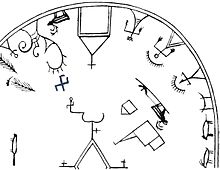
Ukko, Äijä or Äijö, parallel to Uku in Estonian mythology, is the god of the sky, weather, harvest, and thunder across Finnic paganism.

Hrungnir is a jötunn in Norse mythology. He is described as made of stone and is ultimately killed in a duel with the thunder god Thor.

Mjölnir is the hammer of the thunder god Thor in Norse mythology, used both as a devastating weapon and as a divine instrument to provide blessings. The hammer is attested in numerous sources, including the 11th century runic Kvinneby amulet, the Poetic Edda, a collection of eddic poetry compiled in the 13th century, and the Prose Edda, a collection of prose and poetry compiled in the 13th century. The hammer was commonly worn as a pendant during the Viking Age in the Scandinavian cultural sphere, and Thor and his hammer occur depicted on a variety of objects from the archaeological record. Today the symbol appears in a wide variety of media and is again worn as a pendant by various groups, including adherents of modern Heathenry.
Finnish mythology commonly refers of the folklore of Finnish paganism, of which a modern revival is practiced by a small percentage of the Finnish people. It has many shared features with Estonian and other Finnic mythologies, but also with neighbouring Baltic, Slavic and, to a lesser extent, Norse mythologies.
Thor, the god of Norse mythology, has appeared as a character in various comics over the years, appearing in series from a range of publishers.

Thor is a prominent god in Germanic paganism. In Norse mythology, he is a hammer-wielding god associated with lightning, thunder, storms, sacred groves and trees, strength, the protection of humankind, hallowing, and fertility. Besides Old Norse Þórr, the deity occurs in Old English as Þunor ("Thunor"), in Old Frisian as Thuner, in Old Saxon as Thunar, and in Old High German as Donar, all ultimately stemming from the Proto-Germanic theonym *Þun(a)raz, meaning 'Thunder'.

The rowans or mountain-ashes are shrubs or trees in the genus Sorbus of the rose family, Rosaceae. They are native throughout the cool temperate regions of the Northern Hemisphere, with the highest species diversity in the Himalaya, southern Tibet and parts of western China, where numerous apomictic microspecies occur. The name rowan was originally applied to the species Sorbus aucuparia and is also used for other species in the genus Sorbus.

In traditional Sámi music songs and joiks are important musical expressions of the Sámi people and Sámi languages. The Sámi also use a variety of musical instruments, some unique to the Sámi, some traditional Scandinavian, and some modern introductions.

Taston is a hamlet in Spelsbury civil parish, about 1.6 miles (2.6 km) north of Charlbury and 4 miles (6.4 km) southeast of Chipping Norton, Oxfordshire.

Traditional Sámi spiritual practices and beliefs are based on a type of animism, polytheism, and what anthropologists may consider shamanism. The religious traditions can vary considerably from region to region within Sápmi.

A Sámi drum is a shamanic ceremonial drum used by the Sámi people of Northern Europe. Sámi ceremonial drums have two main variations, both oval-shaped: a bowl drum in which the drumhead is strapped over a burl, and a frame drum in which the drumhead stretches over a thin ring of bentwood. The drumhead is fashioned from reindeer hide.

Tanngrisnir and Tanngnjóstr are the goats who pull the chariot of the god Thor in Norse mythology. They are attested in the Poetic Edda, compiled in the 13th century from earlier traditional sources, and the Prose Edda, written by Snorri Sturluson in the 13th century.

Þrymskviða is one of the best known poems from the Poetic Edda. The Norse myth had enduring popularity in Scandinavia and continued to be told and sung in several forms until the 19th century.

Ukonvasara, or Ukonkirves, is the symbol and magical weapon of the Finnish thunder god Ukko, similar to Thor's Mjölnir. Ukonvasara means 'hammer of Ukko'; similarly, Ukonkirves means 'axe of Ukko'. It was said that Ukko created lightning with Ukonvasara.

Mjolnir, known more formally as Mjölnir is a fictional magical weapon appearing in American comic books published by Marvel Comics. It is depicted as the principal weapon of the superhero Thor. Mjolnir, which first appears in Journey into Mystery #83, was created by writers Stan Lee and Larry Lieber and designed by artists Jack Kirby and Joe Sinnott.

In the folklore of the Sámi, a Stállo is a large, human-like creature who likes to eat people and who therefore is usually in some form of hostilities with a human. Stallos are clumsy and stupid, and thus humans often gain the upper hand over them.

A weather god or goddess, also frequently known as a storm god or goddess, is a deity in mythology associated with weather phenomena such as thunder, snow, lightning, rain, wind, storms, tornadoes, and hurricanes. Should they only be in charge of one feature of a storm, they will be called after that attribute, such as a rain god or a lightning/thunder god. This singular attribute might then be emphasized more than the generic, all-encompassing term "storm god", though with thunder/lightning gods, the two terms seem interchangeable. They feature commonly in polytheistic religions, especially in Proto-Indo-European ones.

Jens Andreas Friis was a Norwegian philologist, lexicographer and author. He was a university professor and a prominent linguist in the languages spoken by the Sami people. He is widely recognized as the founder of the studies of the Sami languages. Today he is also commonly associated with his novel Lajla: A New Tale of Finmark, which became the basis for Laila, a 1929 silent film.

Thor Odinson is a superhero appearing in American comic books published by Marvel Comics. Created by artist Jack Kirby, writer Stan Lee, and scripter Larry Lieber, the character first appeared in Journey into Mystery #83 (1962) and first received his own title with Thor #126 (1966). Thor is an adaptation of the deity of the same name from Norse mythology, and many aspects of Thor's character are based on Norse myth. Comic books featuring Thor have been published across several volumes since the character's introduction.
The presence of lightning in religion is an historically existing and currently existing cultural aspect where-by the phenomenon of lightning has and is viewed as part of a deity, or a deity in and of itself.


















